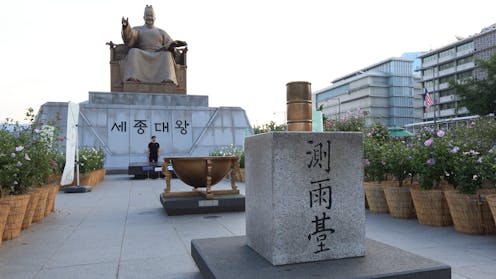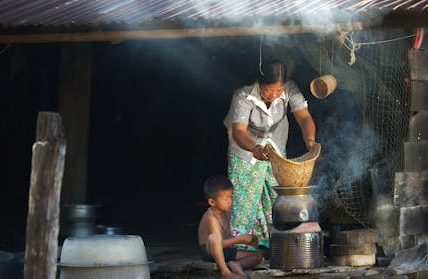What the world can learn from Korea’s 15th-century rain gauge
The rain gauge with a statue of King Sejong the Great in Seoul, Korea. KoreaKHW/Shutterstock
Droughts and floods are becoming more frequent and more severe across the globe. The cause is often rain — either too little or too much. The monsoon regions of the world, where societies have weathered cycles of drought and deluge for thousands of years, hold essential lessons about rainwater monitoring and conservation.
In Korea, one such lesson dates back to the 15th century. In 1441, during the reign of King Sejong, Korea established the world’s first official rain gauge (cheugugi) — a cylindrical copper instrument — and also created a state-administered rain monitoring network.
This wasn’t just a technical invention; it was part of a wider policy. On September 3 of that year, according to the Annals of the Choson Dynasty (a Unesco Memory of the World record), local magistrates across the country were ordered to measure rainfall regularly and report it to the central government.
This system represented one of the earliest forms of climate data governance and set a precedent for valuing rain as a measurable, manageable and fairly governed resource — a public good to be shared and respected. It also reflected a philosophical tradition in Korea of respecting rain not as a curse, but as a gift — one that must be understood, welcomed and shared.
India too has a rich tradition of rainwater harvesting, spanning from the Vedic period and the Indus–Sarasvati Valley civilisation (3,000–1,500BC) to the 19th century. Throughout diverse ecological zones, Indian communities developed decentralised systems to capture and store rainwater. The archaeological site of Dholavira in Gujarat, for example, featured sophisticated reservoirs designed to collect monsoon runoff.
Historical records, including ancient inscriptions, temple documents and folk traditions, indicate that these systems were not only engineered but also governed, with established rules for sharing, maintaining and investing in water as a communal resource. In some regions of India, every third house had its own well. Although these practices declined during colonial rule, they are now being revived by local communities, government initiatives, and non-governmental organisations.
The revival of traditional wells is gaining momentum, particularly in urban areas facing water scarcity. For example in the city of Bengaluru in southern India, local communities and organisations are using age-old well-digging techniques to tap into shallow aquifers. These efforts are often supported by the state or central government, as well as specialists and organisations including the Biome Environmental Trust, Aga Khan Trust for Culture, Indian National Trust for Art and Cultural Heritage, and the Centre for Science and Environment.
India’s current prime minister has also launched a campaign called Jal Shakti Abhiyan: Catch the Rain as part of a nationwide effort to restore and promote community-led rainwater harvesting.
Reviving ancient wisdom
In Korea, there’s also been a resurgence of this ancient wisdom in modern contexts. Although urban initiatives like the Star City rainwater management system show promise, the movement towards reviving old practices like rainwater harvesting is still growing.
Meanwhile in Cambodia, the Rain School Initiative empowers students and teachers to manage rainwater for drinking and climate education. Rainwater is not just a technical solution — it is a cultural key to resilience. It offers autonomy, sustainability and hope.
That is why we propose to establish UN Rain Day on September 3, in recognition of Korea’s historical contribution and in celebration of global rain literacy. It is a symbolic date that reminds us how rain has shaped civilisations and how it can shape our future — if only we choose to listen to the wisdom of water.
Designating international days has proven effective in raising awareness and catalysing global action. For instance, World Water Day (March 22) has spurred international cooperation and policymaking on water issues since its establishment in 1993. World Toilet Day (November 19) has elevated the global conversation around sanitation and public health.
A UN Rain Day would spotlight rain as a vital yet often overlooked resource. This is something that’s especially crucial for climate adaptation in monsoon regions and beyond.
Don’t have time to read about climate change as much as you’d like?
Get a weekly roundup in your inbox instead. Every Wednesday, The Conversation’s environment editor writes Imagine, a short email that goes a little deeper into just one climate issue. Join the 45,000+ readers who’ve subscribed so far.
The authors do not work for, consult, own shares in or receive funding from any company or organisation that would benefit from this article, and have disclosed no relevant affiliations beyond their academic appointment.



